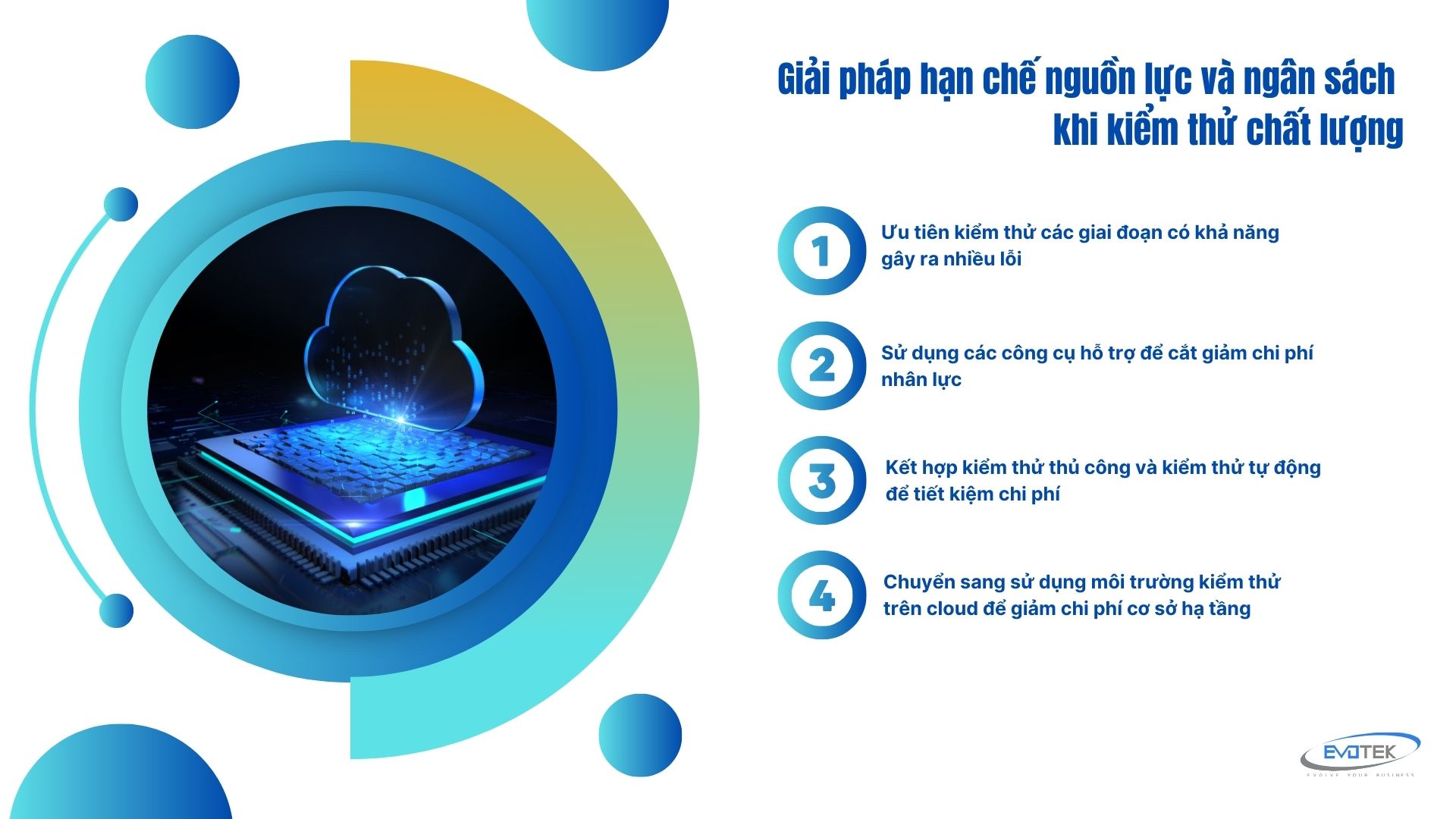In today’s globalized and highly competitive landscape, many companies turn to outsourcing to cut costs, boost productivity, and concentrate on their core functions. According to a 2023 report by Precedence Research, the global IT service outsourcing market is predicted to hit around $1,149.24 billion by 2032.
Quality testing stands as a crucial phase in every software development endeavor. Yet, when businesses opt for outsourcing software testing, they encounter challenges during project execution.
In this article, Evotek will identify the five primary challenges of outsourcing quality testing and provide solutions to address them.
What is software quality testing?
Software quality testing is a vital process that involves various activities aimed at assessing the quality of software products and reducing the risk of errors occurring during real-world usage. In today’s software projects, it has become a mandatory step to ensure the reliability and effectiveness of the software. It plays a crucial role in mitigating risks and preventing errors that may occur during the product development phase. Detecting errors early on enables businesses to minimize both risks and associated costs.
Outsourcing software quality testing occurs when a business chooses to delegate the software testing phase to an external provider, known as an outsourcing business. The primary objective of outsourcing quality testing is to identify software errors, ensure the accuracy, correctness, and completeness of the software, and ensure that the delivered software meets the specified business requirements, standards, and expectations.
Technology progresses rapidly.
As technology continues to advance, the field of testing undergoes constant innovation. Testing professionals must continually enhance their skills, learn, and adapt to new technologies. Moreover, the emergence of new software development and testing methodologies like Agile and DevOps necessitates testers to stay updated and flexible in their approaches. Swiftly responding to changes in technology and methodologies poses a significant challenge for testing and QA teams in today’s digital era.
According to a report by Practi Test, the adoption of the Agile model in companies’ software testing processes has risen from 86% in 2022 to 92% in 2024. While approximately 21% of companies still rely on the Waterfall model, there is a noticeable trend towards transitioning to Agile.
Failing to update knowledge or keep pace with market trends can render testing methods outdated, resulting in ineffective testing practices.
Solution:
- Stay Informed: Keep learning about new technologies and tools in testing. Attend training courses and seminars to enhance your skills.
- Automate Testing: Use AI and machine learning tools to automate testing tasks. This helps improve efficiency and speed up the testing process.
- Build a Strong Team: Assemble a skilled testing and QA team that is open to learning and adaptable to technological changes. This ensures high-quality testing outcomes. Apply flexible project management and testing methods such as Agile and DevOps. Integrate testing throughout the software development lifecycle.
- Build a Strong Team: Assemble a skilled testing and QA team that is open to learning and adaptable to technological changes. This ensures high-quality testing outcomes.
Integrate Agile and DevOps in the testing process
Many companies have long embraced the integration of Agile and DevOps into their testing processes. This integration offers benefits such as automated testing, which reduces testing duration, saves time, and accelerates product launches. However, while testing speeds up, it can also lead to more errors and quality issues toward the end of testing.
Furthermore, seamlessly integrating Agile and DevOps necessitates continuous testing throughout the software development lifecycle, adding complexity to planning and managing the testing process. Concerns about data leakage during integration also weigh on companies’ minds.

To ensure successful integration of Agile and DevOps into testing, companies can implement the following solutions:
- Continuous Testing: Utilize automated testing continuously to prevent errors and ensure consistent quality.
- Early Testing: Conduct testing early in the development cycle to identify and address issues promptly, reducing the time required for fixes.
- Employee Training: Provide employees involved in the testing process with training to enhance their skills and knowledge.
- Tool Integration: Integrate tools such as Jira and TestRail to streamline testing processes and improve efficiency.
Limited Resources and Budget Constraints
In today’s landscape of tightening software development budgets, managers frequently overlook investments in testing and quality assurance processes. According to Statista’s 2022 report, the average budget allocation for software quality testing in the Information Technology sector has decreased from 35% in 2015 to 23% in 2019.
Another common challenge is the shortage of highly skilled personnel. Competing for talented and experienced testers is fierce, leading to difficulties in recruitment and retention. Moreover, enhancing the skills of the testing team requires significant resources and ongoing training efforts.
Furthermore, implementing modern testing technologies and tools entails substantial investments in infrastructure, software, and services. However, managers often underestimate the importance of these investments and tend to reduce testing budgets as a result.
For the most effective and efficient software quality testing, companies can implement the following solutions:
- Prioritize Critical Testing Stages: Focus on testing stages where errors are most likely to occur, ensuring resources are allocated where they are needed most.
- Utilize Support Tools: Employ support tools to reduce the costs associated with human resources, streamlining testing processes and enhancing efficiency.
- Blend Manual and Automated Testing: Strike a balance between manual and automated testing to optimize costs. Automated testing can save time and resources for repetitive tasks, while manual testing ensures thorough examination of critical functionalities.
- Embrace Cloud Testing Environments: Transition to cloud-based testing environments to minimize infrastructure costs. Cloud solutions offer scalability and flexibility, allowing companies to access testing resources as needed without significant upfront investments.

Cultural, Language, and Time Zone Variances
One of the significant challenges in outsourcing quality testing is the contrast in culture, language, and time zone between testing teams and businesses located in different countries. This discrepancy often results in misunderstandings and inefficiencies in communication, coordination, and conveying testing requirements.
Working with suppliers situated in distant time zones presents hurdles in coordination, information exchange, and problem resolution. For instance, if a business is based in North America while the testing team operates in Asia, the time zone difference can range from 12 to 15 hours. Consequently, they can only collaborate and communicate effectively during limited overlapping hours of the day.

Here are solutions to address challenges posed by cultural and language differences and varying time zones when outsourcing:
- Utilize Communication Platforms: Employ tools like Slack, Microsoft Teams, or Asana for swift exchange of information.
- Conduct Virtual Meetings: Organize meetings via Zoom or Google Meet for face-to-face discussions and reporting of encountered issues.
- Hire Language-proficient Personnel: Hiring employees who are fluent in at least two languages to work with. Recruiting bilingual staff members is beneficial for enhancing mutual understanding and ensuring accurate communication of information.
- Onsite Staff Deployment: Consider deploying a portion of the testing team personnel to work directly at the enterprise’s office for a designated period. This fosters improved coordination, enables real-time progress monitoring, and facilitates prompt issue resolution.
Quality Assurance Uncertainty
When outsourcing quality testing, ensuring that quality standards are met can be challenging. According to a December 2022 report by the Consortium for Information and Software Quality (CISQ), poor software quality costs the United States approximately 2.4 trillion USD.
Potential risks include products failing to meet technical specifications, containing errors or defects, or not aligning with actual customer needs. This can result in customer dissatisfaction or even complaints regarding product quality.
The primary reason for this challenge may stem from the testing team lacking competence or failing to adhere to proper testing and quality assurance protocols. Additionally, insufficient supervision and coordination between both parties can contribute to this issue.
To address this challenge, businesses should:
- Engage a Competent Testing Team: Ensure the outsourcing partner’s team possesses sufficient expertise, skills, and experience in quality testing.
- Define a Transparent Testing Process: Establish a well-defined testing process mutually agreed upon by both parties. Adherence to this process is crucial for maintaining product quality.
- Establish Clear Quality Standards: Develop precise quality assessment criteria and indicators, agreed upon by both parties, to provide an accurate basis for evaluation.
By implementing these solutions, businesses can effectively manage and enhance the quality of output products during the outsourcing process.
Risk of Information Breach
When outsourcing quality testing, businesses must share significant confidential information with the service provider. If not handled securely, this poses risks to security and confidentiality.
Sensitive information at risk of exposure includes technical specifications, product designs, development processes, and test data. Unauthorized disclosure of such data can severely impact a company’s competitive edge, potentially resulting in legal conflicts.
The primary cause of information breach risk is the absence of specific policies and regulations governing information security in outsourcing agreements. Additionally, insufficient training and commitment from the service provider’s personnel to adhere to these regulations exacerbate the risk.
To mitigate the risk of information leakage when outsourcing, businesses should implement the following measures:
- Establish Clear Information Security Policies: Develop specific policies and regulations outlining the procedures for sharing, storing, and accessing data with suppliers.
- Enforce Stringent Security Measures: Deploy modern security technologies to safeguard data, conduct regular security assessments, and implement robust security protocols.
- Provide Training: Offer comprehensive information security training for personnel involved in the outsourcing process. Ensure the testing team commits to compliance with information security regulations through training sessions for personnel on both sides.
- Select Certified Providers: Choose outsourcing partners that have obtained ISO 27001 information security certification, demonstrating their commitment to maintaining high standards of data security.
By adopting these solutions, companies can significantly mitigate the risk of sensitive information leakage during outsourcing, safeguarding data security and preserving business interests.
In Conclusion
Quality testing in outsourcing projects presents challenges that can impede the software development process. However, with collaborative efforts and effective corrective actions, businesses and testing teams can overcome these challenges and achieve their desired product quality objectives.
While there are numerous outsourcing quality testing providers available, selecting a reliable testing company with robust quality management practices can be daunting.
With over 6 years of expertise in outsourced software quality testing, Evotek takes pride in being a reputable and professional quality testing service provider for businesses. Whether it’s a large-scale enterprise project or a smaller endeavor, Evotek endeavors to uphold the quality of output products.
Backed by a team of seasoned testing specialists, Evotek employs advanced testing processes and methodologies to identify and rectify product errors prior to delivery. Evotek not only adheres to customer standards and requirements but also offers proactive solutions to streamline processes and enhance product quality.
Moreover, Evotek prioritizes information security during testing services. The company has established stringent policies and regulations on data security and implements modern technical measures to safeguard customer information. Evotek’s personnel undergo training and are committed to upholding information security standards.
